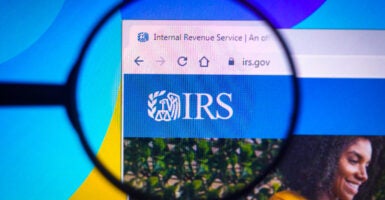In 2021, the IRS issued a report that described what the tax-collecting agency could do with nearly $80 billion in new funding, if only Congress would pass the American Families Plan. The Internal Revenue Service was making the case that the Biden administration’s plan to supercharge funding of the IRS would reap dividends for the federal government.
In a table in that report, the IRS shows that part of the “return on investment” for America would be that by 2031 the IRS could increase the size of its workforce by 86,852 full-time employees.
Last week, that estimate took on renewed significance when the Senate passed HR 5376, the bill called the Inflation Reduction Act but would be more aptly dubbed the IRS Reinforcements Act.
The Inflation Reduction Act includes the same nearly $80 billion in new funding for the IRS over nine years as the American Families Plan, which would increase the IRS’ annual spending by an estimated $14.6 billion by 2031. Since the IRS funding plan remains almost the same, the IRS’ estimate of adding roughly 87,000 full-time employees to its ranks should still be a reasonable approximation.
Unfortunately for the nation’s tax-collecting agency, the idea of adding 87,000 new IRS agents doesn’t appeal to most Americans.
The Senate passage of the Inflation Reduction Act has led many Americans to recount horror stories of IRS harassment. Others remember the political weaponization of the IRS by presidential administrations from Richard Nixon to Barack Obama, not to mention the agency’s still unexplained leak of a massive trove of taxpayer data just a year ago. That data leak was exploited for political purposes.
Now, the IRS and its allies are downplaying the size of the reinforcements they’re receiving, portraying the boost in IRS staffing as a moderate increase that will be largely offset by attrition and other factors.
In a Time fact check, a counselor for tax policy at the Treasury Department was quoted as saying: “There’s a big wave of attrition that’s coming and a lot of these resources are just about filling those positions.”
The Time article claimed that the IRS might net roughly 20,000 to 30,000 more employees from the funding. But this is not what the IRS report from last year said.
While the political calculus may have changed, the numbers haven’t.
The 24-page IRS report has only one rather obscure reference to attrition and that’s not in the context of hiring new agents.
Here’s how the IRS describes the expansion of its workforce: “Because the expansion in the IRS’s budget is phased in over a 10-year horizon, each year the IRS’s workforce should grow by no more than a manageable 15%.”
Notice, the IRS describes a growing workforce, and notice that is a rapid rate. If the IRS were to grow by 15% each year for nine years, that would mean a 252% increase in the size of the IRS’ current 81,836-person workforce. That would mean more than 206,000 more IRS employees than today.
That number is clearly unrealistically high, even for the large amount of funding the IRS would receive. But even if the agency grew at an annual rate of 8.4% for nine years—barely over half of the ceiling described by the IRS—the agency would surpass 87,000 new employees.
But was the IRS right? Is there enough funding in this bill for the agency to add 87,000 employees to its ranks? The numbers projected by the Congressional Budget Office suggest the 87,000 figure is very close.
The IRS spent roughly $13.7 billion in 2021 and had 81,600 employees, or about $167,900 per employee. If the IRS were to hire 87,000 additional employees at the same cost per employee, it would cost $14.6 billion, the same amount of funding that the government forecasters projected the IRS would spend in 2031.
So, yes, the IRS’ own estimate of an 87,000-person expansion of the IRS was solid.
One would hope that with millions more audits of American taxpayers coming, at least taxpayer services would improve. But that’s unlikely.
Only $3.2 billion would go to taxpayer services, despite the IRS answering only 18% of the phone calls it received in 2022. That’s a mere 9% increase for funding in things like account services, taxpayer education, and filing assistance.
The lion’s share of the new funding, $45.6 billion, will go to enforcement activities like new audits, litigation, asset monitoring, and collections.
And don’t be fooled by bogus claims that the middle class won’t be affected by the new audits. As Heritage Foundation senior research fellow Rachel Greszler explains, even a 3,000% increase in audit rates for taxpayers making more than $400,000 would fall well short of raising the new revenues being claimed in 2031.
So, if the Inflation Reduction Act passes the House of Representatives and is signed into law, get ready to dust off your copy of the 7,000-page tax code and 14,000 pages of IRS regulations.
Have an opinion about this article? To sound off, please email [email protected] and we’ll consider publishing your edited remarks in our regular “We Hear You” feature. Remember to include the url or headline of the article plus your name and town and/or state.




























